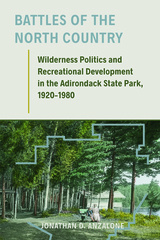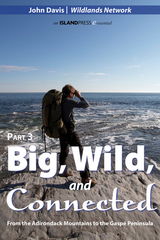3 books about Adirondack Mountains

Battles of the North Country
Wilderness Politics and Recreational Development in the Adirondack State Park, 1920-1980
Jonathan D. Anzalone
University of Massachusetts Press, 2018
The Adirondack region is trapped in a cycle of conflict. Nature lovers advocate for the preservation of wilderness, while sports enthusiasts demand infrastructure for recreation. Local residents seek economic opportunities, while environmentalists fight industrial or real estate growth. These clashes have played out over the course of the twentieth century and continue into the twenty-first.
Through a series of case studies, historian Jonathan D. Anzalone highlights the role of public and private interests in the region and shows how partnerships frayed and realigned in the course of several key developments: the rise of camping in the 1920s and 1930s; the 1932 Lake Placid Olympics; the construction of a highway to the top of Whiteface Mountain; the postwar rise of downhill skiing; the completion of I-87 and the resulting demand for second homes; and the 1980 Lake Placid Olympics. Battles of the North Country reveals how class, economic self-interest, state power, and a wide range of environmental concerns have shaped modern politics in the Adirondacks and beyond.
Through a series of case studies, historian Jonathan D. Anzalone highlights the role of public and private interests in the region and shows how partnerships frayed and realigned in the course of several key developments: the rise of camping in the 1920s and 1930s; the 1932 Lake Placid Olympics; the construction of a highway to the top of Whiteface Mountain; the postwar rise of downhill skiing; the completion of I-87 and the resulting demand for second homes; and the 1980 Lake Placid Olympics. Battles of the North Country reveals how class, economic self-interest, state power, and a wide range of environmental concerns have shaped modern politics in the Adirondacks and beyond.
[more]

Big, Wild, and Connected
Part 3: From the Adirondack Mountains to the Gaspé Peninsula
John Davis
Island Press, 2013
This E-ssential is a three-part series that covers John Davis's epic journey from Florida to Maine. In 2011, with support from the Wildlands Network, Davis traveled 7,600 miles in 10 months from Florida to Maine by foot, bicycle, skis, and canoe/kayak. His extensive traveles were motivated by wanting to answer the question “Is it possible in the twenty-first century to identify and protect a continental-long wildlife corridor that could help to protect eastern nature into the future?”
John paints a vivid picture of the physical challenges of the trek, such as climbing the highest point in South Carolina with a heavily loaded bike and trying to consume the 8,000 calories per day he needed to fuel himself for the journey. As readers adventure with Davis, they will also share his evolving understanding of what it would take to implement an Eastern Wildway.
Eastern wildlife, both seen and unseen, from Florida panthers to North Carolina’s red wolves to the ghosts of cougars farther north, are the real focus of this adventure as John explores how such wildness can coexist with human development in the most populated regions of the United States. The science and conservation of large-scale connectivity are brought to life by his travels—offering unique insights into the challenges and opportunities for creating an Eastern Wildway. This is a must-read for enthusiasts of hiking narratives, as well as professionals and students interested in issues related to large-scale connectivity. Compelling photographs and other graphics complement John’s fascinating story.
[more]

Wolves and Human Communities
Biology, Politics, and Ethics
Edited by Virginia A. Sharpe, Bryan Norton, and Strachan Donnelley
Island Press, 2000
Like wolf restoration activities in the West, the proposal to reintroduce wolves into the Adirondacks has generated intense public debate. The idea of returning top predators to settled landscapes raises complicated questions on issues ranging from property rights to wildlife management to obligations to present and future generations.Wolves and Human Communities brings together leading thinkers and writers from diverse fields -- including Timothy Clark, Daniel Kemmis, L. David Mech, Mary Midgley, Ernest Partridge, Steward T.A. Pickett, Joseph Sax, Rodger Schlickeisen, and others -- to address the complex ethical, biological, legal, and political concerns surrounding wolf reintroduction. Contributors specifically explore the social, cultural, and ecological values that come into play in the debate, as they examine: the views of stakeholders in the Adirondack decision historical trends in public perception of restoration the legal and policy context for species preservation, and the challenges to the current system of property law biological and political lessons learned from Yellowstone, Isle Royale, and the Great Lakes states the meaning of wildness, both in ourselves and the wolf The final chapter by Niles Eldredge takes the point of view of evolutionary time and ecological scale, challenging us to develop a new consciousness regarding our position in the natural world.Wolves and Human Communities offers a thought-provoking examination of interactions between human and wild communities, and represents an important contribution to debates over species reintroduction for policymakers, researchers, ecologists, sociologists, lawyers, ethicists, philosophers, and local residents.
[more]
READERS
Browse our collection.
PUBLISHERS
See BiblioVault's publisher services.
STUDENT SERVICES
Files for college accessibility offices.
UChicago Accessibility Resources
home | accessibility | search | about | contact us
BiblioVault ® 2001 - 2024
The University of Chicago Press









